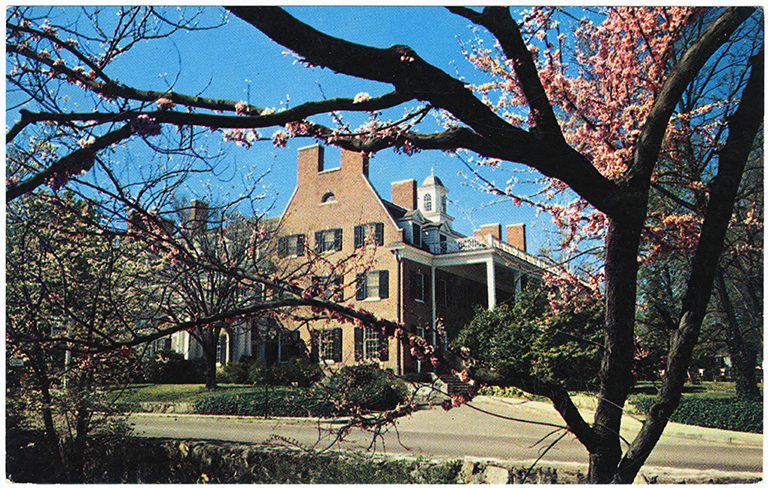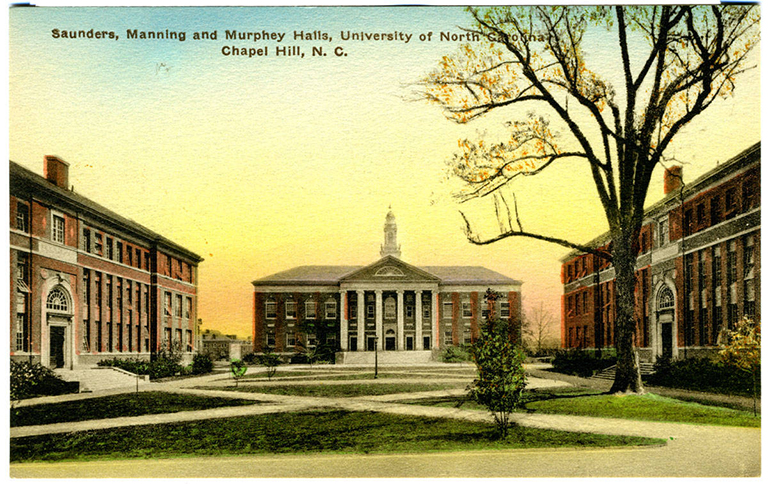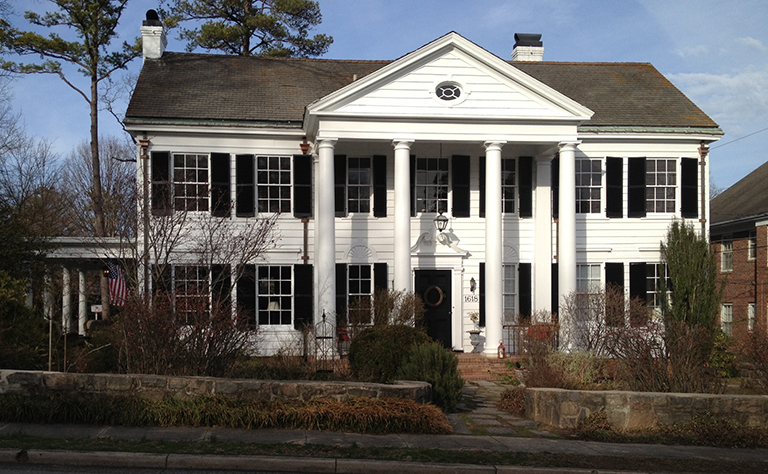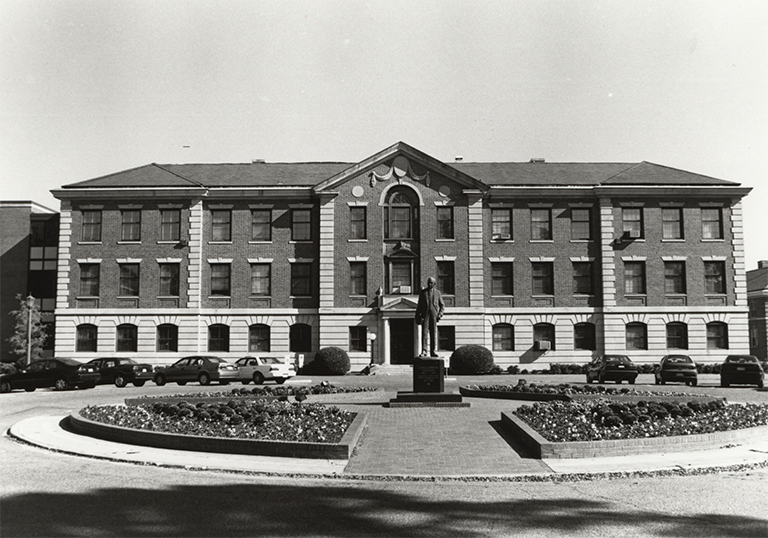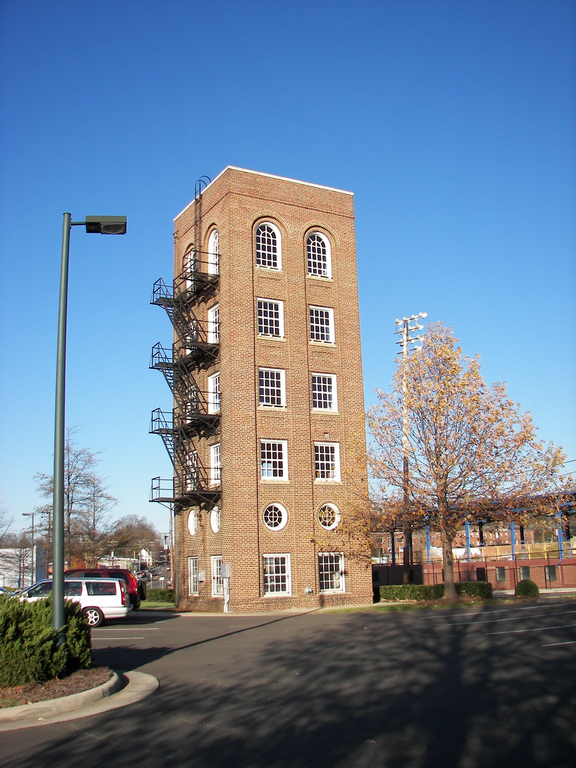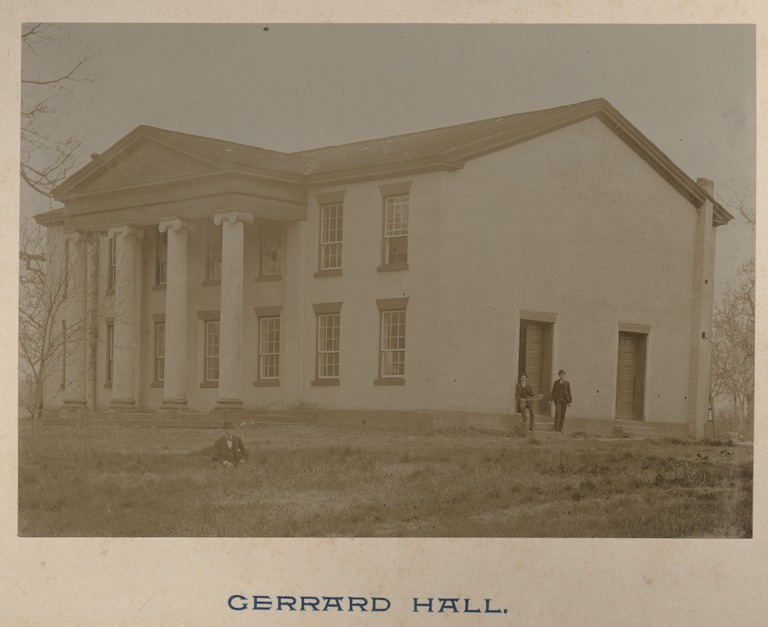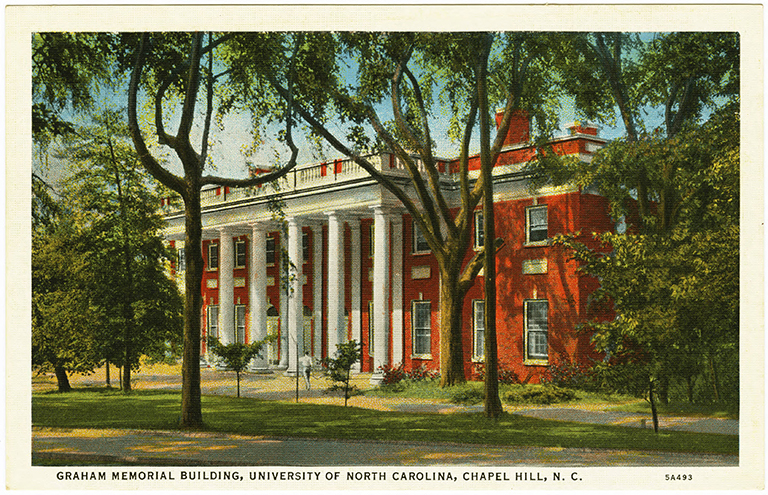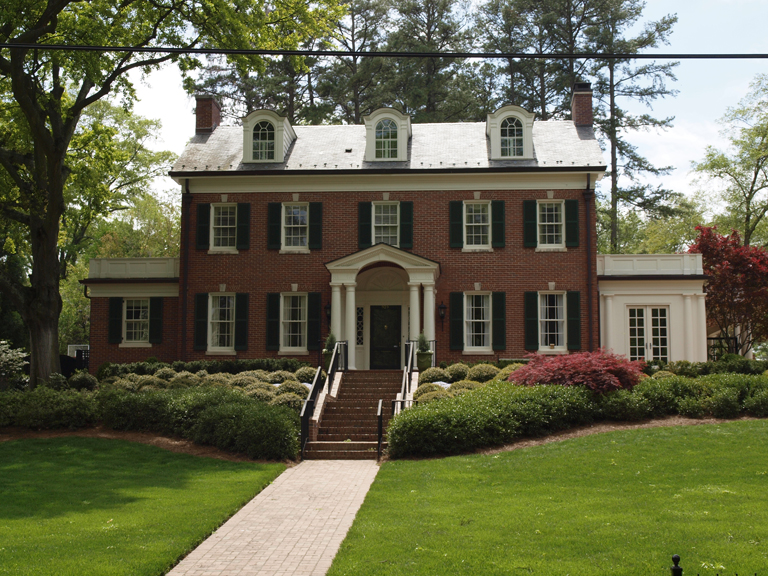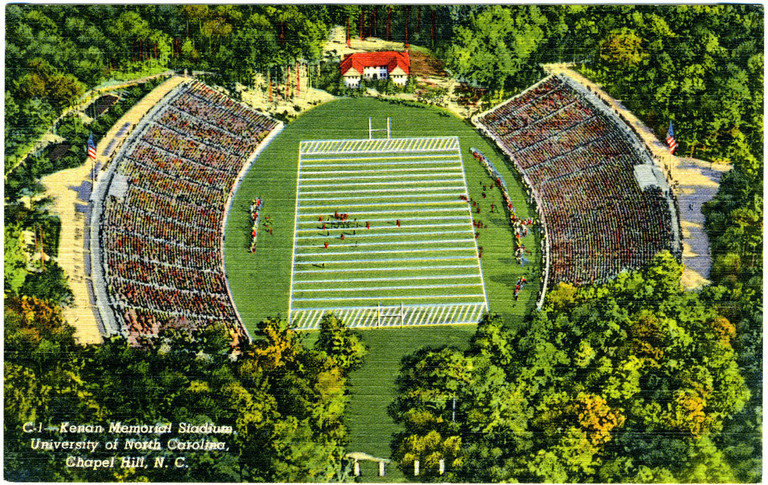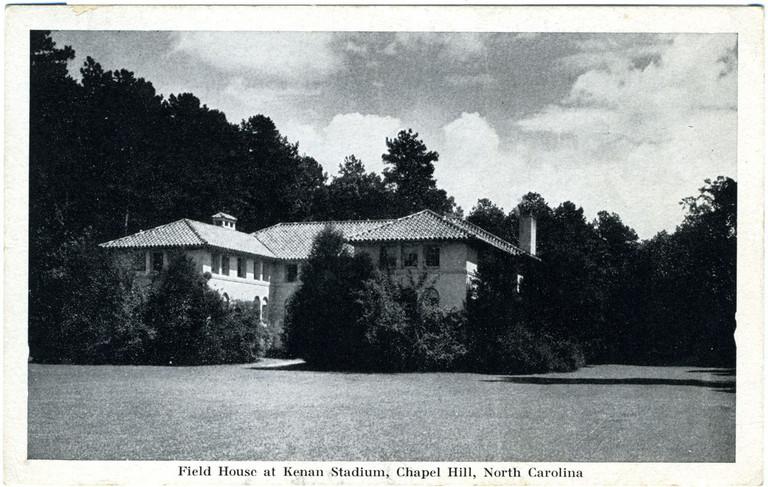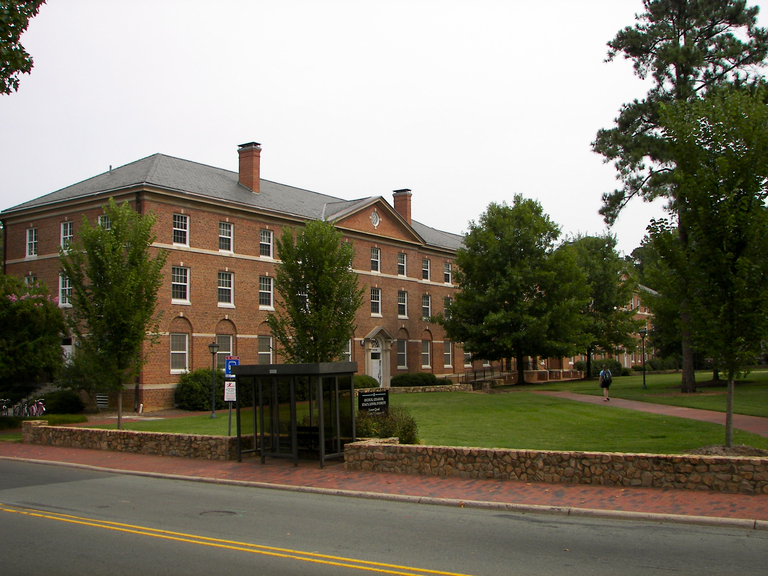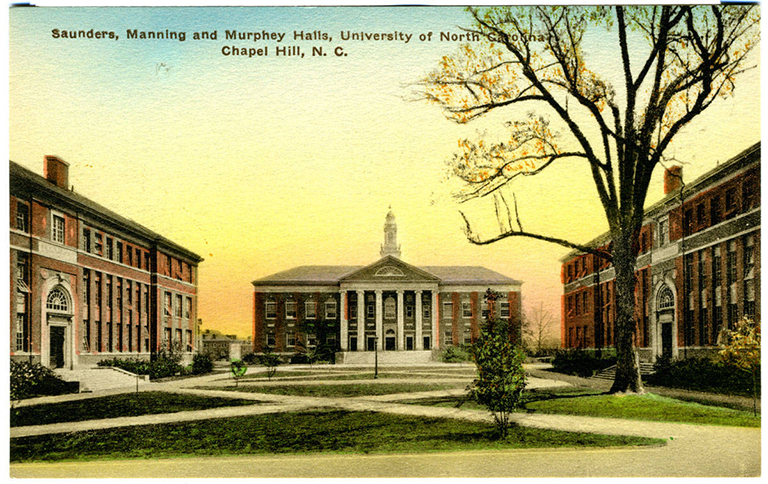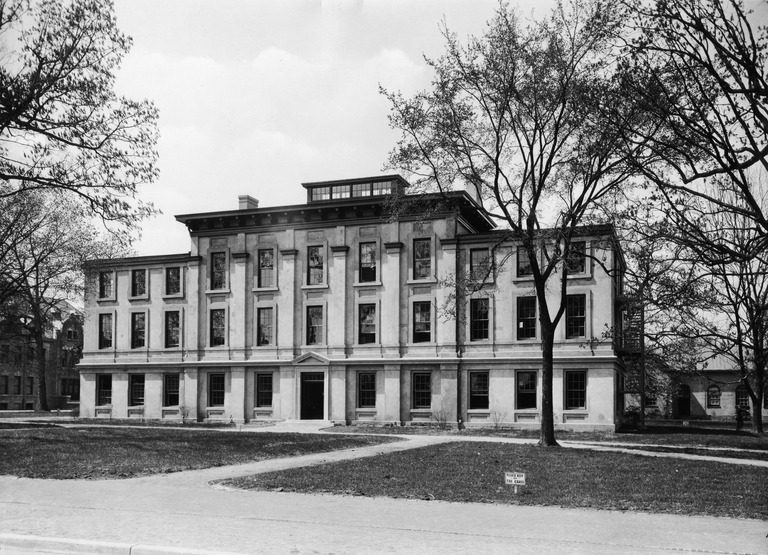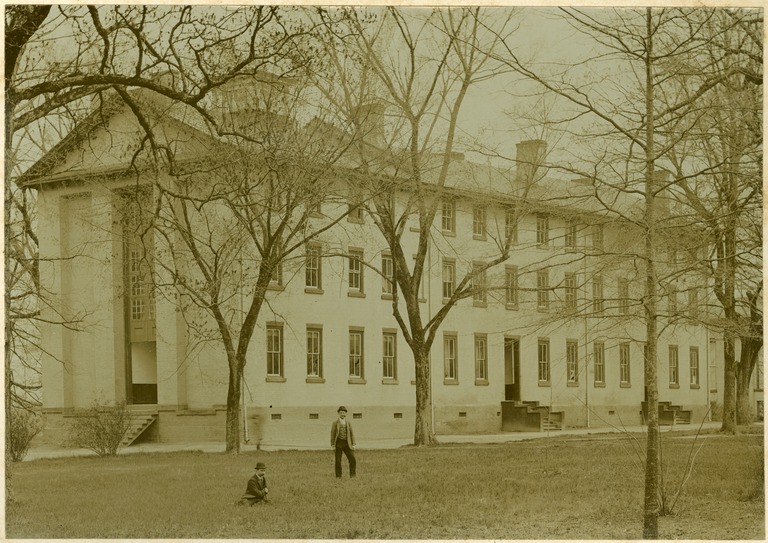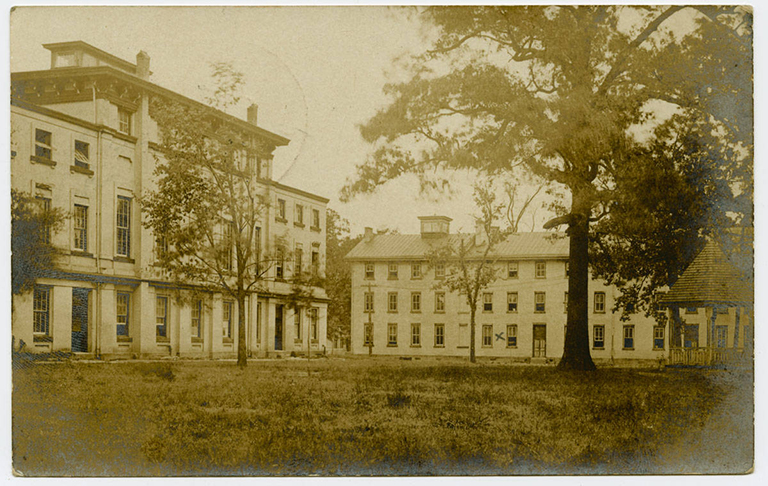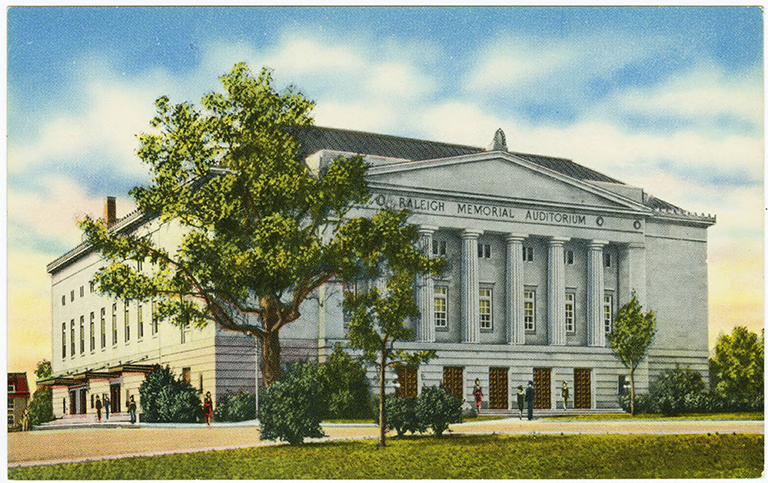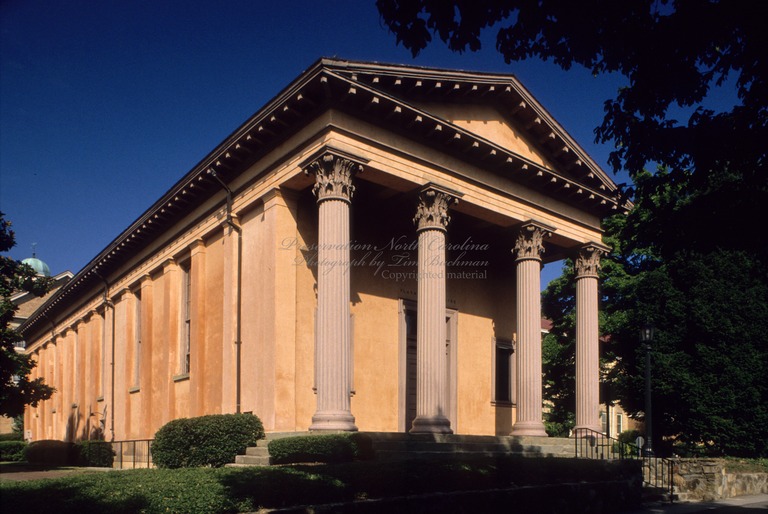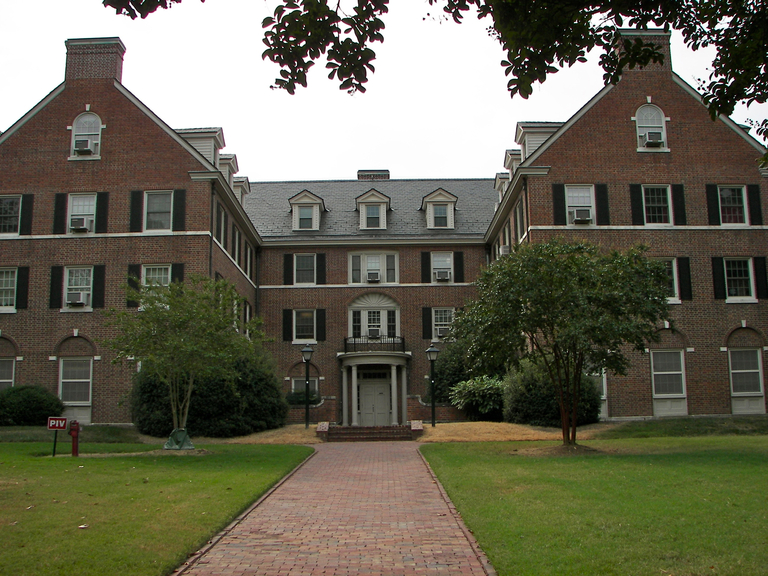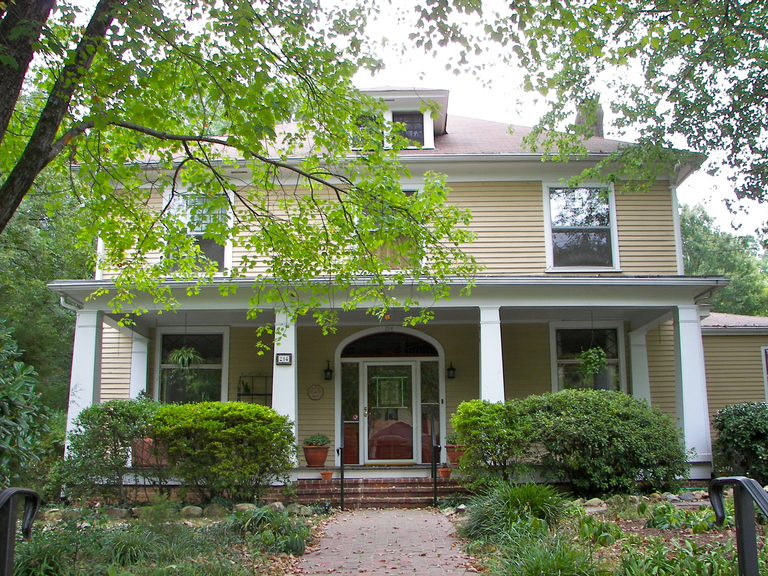Atwood, Thomas C. (1874-1943)
Birthplace:
Provincetown, Massachusetts, USA
Residences:
- Durham, North Carolina
Trades:
- Engineer
Building Types:
Styles & Forms:
Beaux-Arts; Colonial Revival; Georgian Revival; Spanish Colonial Revival
Thomas C. Atwood (December 5, 1874-February 2, 1943) was an engineer and architect from Massachusetts who became a leader in North Carolina’s construction industry in the early twentieth century, first as head of the T. C. Atwood Organization in charge of the major expansion of the University of North Carolina in Chapel Hill and also as senior partner in the firms of Atwood and Nash with Arthur C. Nash and Atwood and Weeks with H. Raymond Weeks. Atwood was especially skilled at handling large projects and working with state leaders, but his firms also planned residences and other smaller works. The building list here represents but a sampling of these firms’ many projects.
Thomas C. Atwood was born in Provincetown, Massachusetts, to John W. and Abbie Atwood. He graduated from MIT in 1897 and in 1901 married Grace M. Winslow; the couple had children Theodore and Robert. As reported in the University of North Carolina Alumni Review of May, 1921, after graduating from MIT in 1897, Atwood was involved in a series of major engineering projects in Boston and Philadelphia, and he served for three years as a division engineer in Pittsburgh and for seven years as designing and division engineer in New York. He gained wide recognition as the supervising engineer of the immense Yale Bowl, and he was an engineer in charge of marine facilities along the Atlantic coast during World War I. He came to North Carolina in 1920 to become chief engineer of the Durham Hosiery Mills, with responsibility for mill and mill village construction.
Atwood arrived in the state at a time when the University of North Carolina was about to embark on an immense construction campaign in which he was to play a central role. The saga of the 1920s university construction campaign and Atwood’s role in it is complex. Planning for expansion of the campus had begun before World War I, and urban planner John Nolen had suggested development toward the south. The war and the death of university president Edward Kidder Graham in the influenza epidemic of 1918 delayed the project. After the war, with a jump in enrollment and the expectation of further growth making new construction urgent, university leaders (including the new president, Harry Chase) and alumni conducted an intensive campaign in 1920-1921 that resulted in unprecedented funding by the state legislature early in 1921. Already, in April 1920 (according to Louis Round Wilson), university leaders had selected McKim, Mead and White of New York as consulting architects for the expansion. The initial funding provided by the legislature was for $1.4 million for the first phase of construction, to be accomplished in 1921-1922.
The management of this immense project on such a short schedule presented an unprecedented challenge. For a time, including a brief period after the selection of McKim, Mead and White, the university expansion project had operated under the aegis of the State Building Committee and the State Architect (established in 1919 to consolidate design and management of state funded building projects). The limited state funds allotted to the office meant that architect James A. Salter conducted its duties on a part-time basis.
Encountering delays and cost overruns while working with Salter during construction of Steele Hall, university leaders realized that the demanding project ahead of them—to plan and build more than a million dollars’ worth of substantial buildings in record time in a relatively isolated location—required a different approach in which the university leadership, not the State Building Commission or State Architect, would have control. Late in 1920, contemporaneously with their fundraising effort, university leaders began a successful campaign to terminate the relationship with the State Architect (see James A. Salter). After considerable debate, the Office of the State Architect was abolished on March 9, 1921, concurrently with legislative authorization of funding for university construction. Thereafter various state entities employed their own architects and contractors for their building projects.
To handle the undertaking at the University of North Carolina, the university trustees appointed a “Trustees’ Building Committee” of powerful alumni and state leaders, including banker and university benefactor John Sprunt Hill of Durham, who played an major role throughout the endeavor. The committee then established a professional engineering and architectural team in residence, with an executive engineer to serve as its agent in consultation with the committee and McKim, Mead and White.
For Thomas C. Atwood, already in Durham and having earned a good reputation for his previous projects and work for the Durham Hosiery Mills, the university project presented the opportunity of a lifetime. He was also on the lookout for work: in an undated letter quoted in MIT’s alumni journal Technology Review of 1921, he wrote to a fellow engineer about this time, “I am now a Tar Heel and have been for a year.” He had been “putting up some big mills” and buying machinery for the Durham Hosiery Mill, but “owing to the slump in the hosiery business, work on the new mills has been stopped and I suppose I shall soon be looking for a big job suited to a small man.” The same journal also reported that by late April, Atwood had become “supervising engineer in charge of the construction of extensive new buildings” for the university—”the biggest piece of construction the university has known.”
Atwood recalled these events in a paper given to the Boston Society of Civil Engineers on January 25, 1922, in which he stated that the trustees of the University of North Carolina were “suddenly confronted with the problem of spending some $1 500 000 in buildings and other improvements. I say suddenly, because within a few days near the close of the last regular session, the legislature appropriated this sum and also abolished the State Building Commission, which had up to that time handled the construction work for all state institutions and threw each institution upon its resources. The Trustees appointed an unusually able Building Committee which desired to proceed at once with the work as the need of increased facilities was great.” Indicating his own role in defining the new approach, Atwood stated, “The program which I suggested to them seemed to me the correct analysis of the situation, and they engaged me to carry it out.”
From this account, it appears that Atwood had discussed with one or more of the trustees and possibly President Chase the best means of managing the project. More than likely John Sprunt Hill of Durham, a leading voice in the campaign to abolish the State Architect’s office in 1920-1921, was instrumental in bringing Atwood on board.
Atwood explained that the program he recommended and which the university adopted, was “in brief, first to organize a force of architects and engineers to design the work on the ground and supervise its construction and second to let the entire work to a capable contracting firm on some form of cost plus contract and to get them started just as soon as the plans could be prepared.” He also explained the rationale for having a lump sum contract rather than individual contracts to conduct the work in a labor-short, small-town setting and to meet the “desire to control the speed of progress.”
In any case, the News and Observer of April 17, 1921 reported that on the previous day the university building committee and the executive committee of the board of trustees had embarked on the building program with Atwood “to be in direct charge.” This action “ratif[ied] the recommendations of the Building committee” at their meeting on March 30 “for the retention of Mr. Atwood and the immediate beginning of buildings operations.” There was some concern over possible delays in state funding due to instability in the bond market, but the newspaper reported that several bankers had agreed to provide financial assistance if needed. Atwood was planning to begin work the next day, with the promise of having buildings ready for the incoming students the next fall. The Daily Tar Heel noted on April 26 that as “executive officer of the Building Committee” Atwood would “act for it in the placing of contracts and in the general supervision and inspection of the work, and he will be directly responsible for the biggest piece of construction work the University has ever known.”
Having indeed landed the “big job” he had hoped for, Atwood formed the “T. C. Atwood Organization,” which employed additional engineers, draftsmen, and an architect. On May 9, the Charlotte News reported that university president H. W. Chase had that day announced that “the architectural work on the $1,490,000 building program will be under the direction of H. P. Alan Montgomery, of New York.” Atwood also advertised widely for lump sum bids for the whole $1,100,000 building contract (see advertisements, News and Observer, May 20, 1921, Wilmington Morning Star, May 21, 1921, etc.). The contract for the initial two-year, multi-building project went to T. C. Thompson of Charlotte, as spelled out in a detailed agreement of June 17, 1921(reprinted in the Journal of the Boston Society of Civil Engineers, 9, 62-65). This unusual arrangement spurred complaints from many of the state’s contractors—as reported in the Winston-Salem Journal of May 22, 1921 and other newspapers—but the university proceeded nonetheless with the system its leaders described as the most efficient for such an undertaking in both time and money.
Less than a year later, the Daily Tar Heel of January 22, 1922 lauded the progress made in recent months and stated, “The appointment of the Atwood organization to supervise the building program came as a result of the act by the last legislature abolishing the State Building Commission, which had hitherto had the work in charge. The act abolishing the building commission was simultaneous with the granting of $1,400,000 to the University and various sums to kindred institutions for physical expansion.”
Among the advantages of this system, the Daily Tar Heel reported, was that it assured unified planning and architecture: the university’s expansion, as laid out by the firm of McKim, Mead and White and managed by Atwood, would adhere to “symmetry of arrangement, and congruity of architectural features.” There would thus be “no more of the former tactics of some member of the building commission running over the project and deciding hastily that a pressed building will do, and then going out on the campus and marking a spot with his heel and decreeing that ‘We’ll put ‘er here, boys.’”
Especially important, continued the report, were the economic advantages of predictability, economy, and continuity, and the prospect of maintaining a consistent labor force. The program prevented having different contractors competing for workers or workers bargaining with different contractors for better wages, as well as the complexity of different contractors reporting to the superintending engineer. The Greensboro Daily News of August 6, 1922, explaining the “innovation in public building projects” noted that as “executive agent,” Atwood had “organized a staff that included an architect, draughtsmen, inspectors, bookkeepers and auditors. A single contract was let for the entire construction undertaking. The contractor receives for his services a fixed sum amounting to just over 4 per cent of the cost of the buildings. He guarantees his estimates on any given structure when the completed plans are turned over to him. If the cost is below the guarantee the university gets the saving; if it is above, the loss is the contractor’s.” As Atwood acknowledged, such an arrangement “requires a considerable degree of mutual confidence between the contractor and engineer,” but as of 1922 the system was working well.
As work proceeded, Atwood confronted various challenges, including delays due to weather and strikes by some of the workmen. For reasons not yet explained, early in 1922 architect H. P. Alan Montgomery left the project, and in April Arthur C. Nash, also of New York, replaced him as architect for the T. C. Atwood Organization. Nash and Atwood formed an effective and compatible team that would last through the 1920s. The Charlotte News of August 27, 1922, stated that the university president and trustees anticipated the system would serve well as the university grew to meet mounting needs. Over the next several years until the effects of the Great Depression halted funding, the campus building program continued with additional if not always sufficient funding from the legislature and with Thomas C. Atwood and Arthur C. Nash along with representatives from McKim, Mead and White—chiefly William M. Kendall (see Kendall and Taylor)—collaborating on architectural matters.
The South Quad (known today as Polk Place) was the central feature of the new South Campus, lined by buildings in restrained, red brick Georgian Revival style along its sides and secondary axes. Forming the imposing south terminus was the neoclassical Louis Round Wilson Library in pale stone, designed by Nash and Kendall. Additional buildings beyond Polk Place included several dormitories such as Spencer Hall, the first dormitory constructed for women at the university. The “colonial” vocabulary continued to define the campus even after the construction hiatuses of the Great Depression and World War II.
Meanwhile, Thomas C. Atwood and Arthur C. Nash also formed the partnership of Atwood and Nash (in April 1922, according to university historian Louis Round Wilson, but certainly by 1923, as shown in the Daily Tar Heel of October 6, 1923). This firm took on numerous private and public projects. Some projects were cited to the Atwood organization with Nash as architect, others to the firm of Atwood and Nash. Within their familiar Georgian Revival vocabulary, Atwood and Nash planned new buildings for North Carolina Central University in Durham and for Peace College in Raleigh. Quite a different spirit informed their State Fair Exhibition Buildings in Raleigh, an expansive, stuccoed structure with cheery Spanish character.
Nash retired in 1930, and by 1931 Atwood formed a partnership association with architect H. Raymond Weeks, who had previously worked with Atwood and Nash, while Nash continued to offer consulting services to the firm and the university.
Atwood and Weeks’s association proved to be a fruitful one, including work for the university and other projects. Among their best known edifices are the Raleigh Memorial Auditorium, a dignified classical edifice with Doric portico, constructed by builder C. V. York, and the United States Post Office in Durham. Atwood died in 1943. Weeks continued to practice under his own name for several years and served as architect for the university, continuing the “colonial” vocabulary established in the 1920s by Atwood and Nash. Note: The building list includes only a sampling of the many works by Atwood’s firms. Dates and architects for buildings at the University of North Carolina are drawn from Henderson, The Campus of the First State University.
- Collection Number 40102, “Physical Plant of the University of North Carolina at Chapel Hill Records, 1904-1963,” University of North Carolina at Chapel Hill Library, Chapel Hill, North Carolina.
- Archibald Henderson, The Campus of the First State University (1949).
- Journal of the Boston Society of Civil Engineers, 9 (1922).
- Technology Review (Association of Alumni and Alumnae of the Massachusetts Institute of Technology), 23 (1921).
- Who’s Who in Engineering (1922).
- Louis Round Wilson, The University of North Carolina 1900-1930 (1957).
Alderman Hall
Contributors:Dates:1937
Location:Chapel Hill, Orange CountyStreet Address:University of North Carolina at Chapel Hill Campus, Chapel Hill, NC
Status:Standing
Type:Educational
Note:Blueprints for this project are held by the University of North Carolina Library, Chapel Hill, in Collection Number 40102, “Physical Plant of the University of North Carolina at Chapel Hill Records, 1904-1963.”
Alexander Dormitory
Contributors:Thomas C. Atwood, engineer; Atwood and Weeks, architects; Arthur C. Nash, consulting architect; H. Raymond Weeks, architectDates:1939
Location:Chapel Hill, Orange CountyStreet Address:University of North Carolina at Chapel Hill, Chapel Hill, NC
Status:Standing
Type:Educational
Alexander Dunn Hall
Contributors:Dates:1930
Location:Durham, Durham CountyStreet Address:North Carolina Central University Campus, Lawson St., Durham, NC
Status:Standing
Type:Educational
Images Published In:Claudia P. Roberts (Brown) and Diane E. Lea, The Durham Architectural and Historic Inventory (1982).
Alexander Sprunt House
Contributors:Dates:1929-1930
Location:Wilmington, New Hanover CountyStreet Address:1615 Chestnut St., Wilmington, NC
Status:Standing
Type:Residential
Note:Blueprints and specifications for the Sprunt house, by Atwood and Nash and signed by both men, survive in private hands and depict the evolution of the design of the large Colonial Revival residence.
Annie Day Shepard Hall
Contributors:Dates:1930
Location:Durham, Durham CountyStreet Address:North Carolina Central University Campus, Lawson St., Durham, NC
Status:Standing
Type:Educational
Images Published In:Claudia P. Roberts (Brown) and Diane E. Lea, The Durham Architectural and Historic Inventory (1982).
Note:The building was named for the wife of college president James Shepard; she was the granddaughter of the noted Caswell County cabinetmaker Thomas Day.
Baldwin's Department Store
Contributors:Dates:1927
Location:Durham, Durham CountyStreet Address:107 W. Main St., Durham, NC
Status:Standing
Type:Commercial
Images Published In:Claudia P. Roberts (Brown) and Diane E. Lea, The Durham Architectural and Historic Inventory (1982).
Bingham Hall
Contributors:Thomas C. Atwood, engineer; William M. Kendall, consulting architect; McKim, Mead and White, consulting architects; Arthur C. Nash, architect; T. C. Thompson, contractorsDates:1920s
Location:Chapel Hill, Orange CountyStreet Address:University of North Carolina Campus, Chapel Hill, NC
Status:Standing
Type:Educational
Images Published In:M. Ruth Little, The Town and Gown Architecture of Chapel Hill, North Carolina, 1795-1975 (2006).
Note:Bingham Hall, which completed the east side of the South Quad, was initially designed by H. Alan Montgomery but was built a few years later with Arthur C. Nash as building architect. It anchors the southeastern corner of the quad.
Carolina Hall
Contributors:T. C. Atwood Organization, engineers; Thomas C. Atwood, engineer; William M. Kendall, consulting architect; McKim, Mead and White, consulting architects; H. P. Alan Montgomery, architect; T. C. Thompson, contractorVariant Name(s):Saunders Hall
Dates:1922
Location:Chapel Hill, Orange CountyStreet Address:University of North Carolina at Chapel Hill Campus, Chapel Hill, NC
Status:Standing
Type:Educational
Note:The postcard shows Carolina Hall on the left. Built as Saunders Hall, it was renamed Carolina Hall in 2015.
Carolina Inn
Contributors:Dates:1923-1924
Location:Chapel Hill, Orange CountyStreet Address:Corner of Cameron St. and Columbia St., Chapel Hill, NC
Status:Altered
Type:Commercial
Images Published In:M. Ruth Little, The Town and Gown Architecture of Chapel Hill, North Carolina, 1795-1975 (2006).
William S. Powell, The First State University: A Pictorial History of the University of North Carolina (1992).
Cheshire House
Contributors:Atwood and Nash, architects (ca. 1924); Thomas C. Atwood, engineer (ca. 1924); Arthur C. Nash, architect (ca. 1924); Howard E. Satterfield, builder (late 1910s)Variant Name(s):Bishop Joseph B. Cheshire House
Dates:late 1910s; ca. 1924
Location:Raleigh, Wake CountyStreet Address:1618 Ambleside Dr., Raleigh, NC
Status:Standing
Type:Residential
Note:Attorney Joseph B. Cheshire, Jr., son of the Episcopal bishop of the same name, appeared in the city directory of 1917 as residing on Hawthorne Road, and from 1918 onward had the address of 1618 Ambleside. (The property is located at the corner of the two streets.) It is believed that Satterfield built a moderate sized house for Cheshire at first, and then expanded or rebuilt it about 1924 as the present columned residence from designs by Atwood and Nash. Satterfield’s building list includes a job for Joe Cheshire.
Clyde R. Hoey Administration Building
Contributors:Dates:1929
Location:Durham, Durham CountyStreet Address:North Carolina Central University Campus, Lawson St., Durham, NC
Status:Standing
Type:Educational
Images Published In:Claudia P. Roberts (Brown) and Diane E. Lea, The Durham Architectural and Historic Inventory (1982).
Durham Fire Training Tower
Contributors:Dates:1928
Location:Durham, Durham CountyStreet Address:Washington St., Durham, NC
Status:Standing
Type:Public
Frederick Koch House
Contributors:Dates:1924
Location:Chapel Hill, Orange CountyStreet Address:Tenney Circle, Chapel Hill, NC
Status:Unknown
Type:Residential
Note:The Daily Tar Heel of October 18, 1924, reported that Atwood and Nash had designed a residence for Professor Koch.
George E. Kidder House
Contributors:Dates:1931
Location:Wilmington, New Hanover CountyStreet Address:2607 Hydrangea Dr., Wilmington, NC
Status:Standing
Type:Residential
Note:Atwood and Nash’s plans for the Georgian Revival residence survive in private hands.
Gerrard Hall
Contributors:Atwood and Nash, architects and engineers (1938); Thomas C. Atwood, engineer (1938); Arthur C. Nash, consulting architect (1938); William Nichols, architect (1822-1837); Thomas A. Waitt, builder (1837); H. Raymond Weeks, architect (1938)Variant Name(s):New Chapel
Dates:1822-1837; 1858 [improvements]; 1938 [internally reconstructed]
Location:Chapel Hill, Orange CountyStreet Address:University of North Carolina, Chapel Hill, NC
Status:Standing
Type:Educational
Images Published In:John V. Allcott, The Campus at Chapel Hill: Two Hundred Years of Architecture (1986).
M. Ruth Little, The Town and Gown Architecture of Chapel Hill, North Carolina, 1795-1975 (2006).
C. Ford Peatross, William Nichols, Architect (1979).
William S. Powell, The First State University: A Pictorial History of the University of North Carolina (1992).Note:As built from Nichols’s design, Gerrard Hall included an imposing Ionic portico on one side; the portico was removed ca. 1900, and recreated in 2007-2008. The hall was rebuilt internally in the 1930s.
Graham Memorial
Contributors:Atwood and Nash, architects; Thomas C. Atwood, engineer; William M. Kendall, architect; McKim, Mead and White, consulting architects; Arthur C. Nash, architect; T. C. Thompson, contractorDates:1929-1931
Location:Chapel Hill, Orange CountyStreet Address:University of North Carolina Campus, Chapel Hill, NC
Status:Standing
Type:Educational
Images Published In:M. Ruth Little, The Town and Gown Architecture of Chapel Hill, North Carolina, 1795-1975 (2006).
William S. Powell, The First State University: A Pictorial History of the University of North Carolina (1992).Note:The Daily Tar Heel of April 11, 1922 reported that Thomas C. Atwood and William Kendall (of McKim, Mead and White) had conferred with the Graham Memorial Building Committee concerning the best location for a campus edifice to honor the late university president, Edward Kidder Graham, an idea conceived as early as 1920. Other architects had been considered: Hobart B. Upjohn, R. B. McGoodwin, and Charles C. Hook. On May 12, the Daily Tar Heel reported that the T. C. Atwood Organization was busy working on plans; in the interim, architect Arthur C. Nash had come to Chapel Hill to serve as chief architect for the Atwood organization. The building was constructed in stages and remained unfinished for several years because donations sufficient for completion were slow in coming, but a large gift finally enabled it to be completed in 1931 and dedicated in January, 1932. Based on Archibald Henderson’s list of buildings, this was the last of the campus buildings for which the contractors were T. C. Thompson and Brothers; thereafter a variety of contractors constructed the university buildings. It was also the last for which the firm of McKim, Mead and White was listed as consulting architects to Arthur C. Nash.
Hill Hall
Contributors:Atwood and Nash, architects and engineers (1930); Thomas C. Atwood, engineer (1930); J. A. Jones, contractor (1907); Frank Pierce Milburn, architect (1907); Arthur C. Nash, architect (1930); Michael Heister, architectVariant Name(s):Carnegie Library
Dates:1907; 1930 [remodeled]
Location:Chapel Hill, Orange CountyStreet Address:University of North Carolina, Chapel Hill, NC
Status:Standing
Type:Educational
Images Published In:M. Ruth Little, The Town and Gown Architecture of Chapel Hill, North Carolina, 1795-1975 (2006).
Daniel J. Vivian, “‘A Practical Architect’: Frank P. Milburn and the Transformation of Architectural Practice in the New South, 1890-1925,” Winterthur Portfolio (Spring 2005).Note:The building was erected in 1907 as a library and was later expanded and updated as a music building; it has since been renovated again.
Institute of Government
Contributors:Dates:1939
Location:Chapel Hill, Orange CountyStreet Address:University of North Carolina at Chapel Hill Campus, Chapel Hill, NC
Status:Standing
Type:Educational
John Sprunt Hill House
Contributors:Dates:Ca. 1927
Location:Biltmore Forest, Buncombe CountyStreet Address:41-43 Hilltop Rd., Biltmore Forest, NC
Status:Standing
Type:Residential
Note:The large Tudor Revival house was designed by the firm of Atwood and Nash for business and university leader John Sprunt Hill. Biltmore Forest was a separate community, laid out with a golf course and other amenities, on a portion of the Biltmore Estate.
Jolly-Broughton House
Contributors:Atwood and Nash, architects; Thomas C. Atwood, engineer; Arthur C. Nash, architect; Howard E. Satterfield, builderVariant Name(s):Gov. J. Melville Broughton House
Dates:1928
Location:Raleigh, Wake CountyStreet Address:929 Holt Dr., Raleigh, NC
Status:Standing
Type:Residential
Note:The classic Georgian Revival house was built for Janie Jolly, the widow of Frank Jolly and was later purchased by Gov. Broughton. Satterfield’s building list includes a project for Mrs. Frank Jolly, and he is noted as the builder in the Hayes Barton National Register of Historic Places nomination. Blueprints for the house by Atwood and Nash (held by Special Collections Research Center, NCSU Libraries), show two phases of the design, the first in 1928 and a slightly simplified version in 1929. A recent renovation carried out some of the features that were originally omitted including a kitchen wing on the left.
Kenan Dormitory
Contributors:Thomas C. Atwood, engineer; Atwood and Weeks, architects; Arthur C. Nash, consulting architect; H. Raymond Weeks, architectDates:1937-1939
Location:Chapel Hill, Orange CountyStreet Address:University of North Carolina at Chapel Hill Campus, Chapel Hill, NC
Status:Standing
Type:Educational
Note:Blueprints for Kenan Hall are at the University of North Carolina Library, Chapel Hill, in Collection Number 40102, “Physical Plant of the University of North Carolina at Chapel Hill Records, 1904-1963.”
Kenan Stadium
Contributors:Thomas C. Atwood, engineer; William M. Kendall, consulting architect; McKim, Mead and White, consulting architects; Arthur C. Nash, architect; T. C. Thompson, contractorsDates:1927-1934
Location:Chapel Hill, Orange CountyStreet Address:University of North Carolina Campus, Chapel Hill, NC
Status:Altered
Type:Recreational
Images Published In:William S. Powell, The First State University: A Pictorial History of the University of North Carolina (1992).
Note:Kenan Stadium has been much enlarged and changed over the years to accommodate larger crowds and more elaborate seating areas. Still remaining from Nash’s design is the Beaux-Arts plaque with the names of William Rand Kenan and his wife who dedicated the structure to his parents. It is set against Nash’s original stones. For Kenan Stadium, 12 blueprints, tracings, and oilcloth drawings from Atwood and Nash are at University of North Carolina Library, Chapel Hill, in Collection Number 40102, “Physical Plant of the University of North Carolina at Chapel Hill Records, 1904-1963.”
Kenan Stadium Field House
Contributors:Thomas C. Atwood, engineer; William M. Kendall, consulting architect; McKim, Mead and White, consulting architects; Arthur C. Nash, architect; T. C. Thompson, contractorsDates:1927
Location:Chapel Hill, Orange CountyStreet Address:University of North Carolina Campus, Chapel Hill, NC
Status:No longer standing
Type:Recreational
Images Published In:William S. Powell, The First State University: A Pictorial History of the University of North Carolina (1992).
Note:The Spanish Colonial Revival style Field House was razed in 2010 to make way for new seating and other accommodations.
Lenoir Dining Hall
Contributors:Thomas C. Atwood, engineer; Atwood and Weeks, architects; Arthur C. Nash, consulting architect; H. Raymond Weeks, architectDates:1939
Location:Chapel Hill, Orange CountyStreet Address:University of North Carolina at Chapel Hill Campus, Chapel Hill, NC
Status:Standing
Type:Educational
Louis Round Wilson Library
Contributors:Atwood and Nash, architects; Thomas C. Atwood, engineer; William M. Kendall, architect; McKim, Mead and White, consulting architects; Arthur C. Nash, architect; T. C. Thompson, contractorsVariant Name(s):Wilson Library
Dates:1928-1929
Location:Chapel Hill, Orange CountyStreet Address:University of North Carolina Campus, Chapel Hill, NC
Status:Standing
Type:Educational
Images Published In:John V. Allcott, The Campus at Chapel Hill: Two Hundred Years of Architecture (1986).
Catherine W. Bishir, North Carolina Architecture (1990).
Catherine W. Bishir and Michael T. Southern, A Guide to the Historic Architecture of Piedmont North Carolina (2003).
M. Ruth Little, The Town and Gown Architecture of Chapel Hill, North Carolina, 1795-1975 (2006).Note:The Daily Tar Heel of October 13, 1929, carried a long story about the library and its dedication ceremony, at which Governor O. Max Gardner was to present the building on behalf of the people of North Carolina, and John Sprunt Hill, chairman of the university board of trustees, was to accept it on behalf of the university trustees. The article noted that the library was “designed by Atwood and Nash, Inc., University architects and engineers, with the firm of McKim, Mead, and White as consulting architects. T. C. Thompson and Brothers were the constructors [sic].” The article described the edifice including the limestone façade with its portico of Corinthian columns, and interior spaces finished with marble, terrazzo, and travertine. The building was planned to hold 400,000 volumes, with the expectation of future expansion to hold more than a million. The library, which evokes McKim, Mead and White’s famed Low Library at Columbia University, was a fitting terminus to the grand new southern quadrangle of the university. It is among the finest Beaux-Arts classical buildings in the state and remains revered and well used.
Louisburg College Dormitory
Contributors:Variant Name(s):Wright Dormitory
Dates:1925-1926
Location:Louisburg, Franklin CountyStreet Address:Louisburg College Campus, N. Main St., Louisburg, NC
Status:Standing
Type:Educational
Lower Quad Dormitories
Contributors:Thomas C. Atwood, engineer; William M. Kendall, consulting architect; McKim, Mead and White, consulting architects; Arthur C. Nash, architect; T. C. Thompson, contractorsVariant Name(s):Lewis Hall; Graham Hall; Everett Hall; Aycock Hall
Dates:1924-1928
Location:Chapel Hill, Orange CountyStreet Address:University of North Carolina Campus, Chapel Hill, NC
Status:Standing
Type:Educational
Images Published In:M. Ruth Little, The Town and Gown Architecture of Chapel Hill, North Carolina, 1795-1975 (2006).
William S. Powell, The First State University: A Pictorial History of the University of North Carolina (1992).Note:The four dormitories form the Lower Quad. A fifth, Stacy, was added in 1938.
Manning Hall
Contributors:Thomas C. Atwood, engineer; William M. Kendall, consulting architect; McKim, Mead and White, consulting architects; Arthur C. Nash, architect; T. C. Thompson, contractorsDates:1923
Location:Chapel Hill, Orange CountyStreet Address:University of North Carolina Campus, Chapel Hill, NC
Status:Standing
Type:Educational
Images Published In:M. Ruth Little, The Town and Gown Architecture of Chapel Hill, North Carolina, 1795-1975 (2006).
Note:According to Archibald Henderson, The Campus of the First State University (1949), Manning Hall’s architects included both H. P. Alan Montgomery and Arthur C. Nash, suggesting that Montgomery initially designed it, but Nash as his successor completed the building. The postcard shows Manning Hall in the center.
McIver Dormitory
Contributors:Thomas C. Atwood, engineer; Atwood and Weeks, architects; Arthur C. Nash, consulting architect; H. Raymond Weeks, architectDates:1937-1939
Location:Chapel Hill, Orange CountyStreet Address:University of North Carolina at Chapel Hill Campus, Chapel Hill, NC
Status:Standing
Type:Educational
Note:For McIver Hall, 10 sheets of blueprints from Atwood and Weeks are held by the University of North Carolina Library, Chapel Hill, in Collection Number 40102, “Physical Plant of the University of North Carolina at Chapel Hill Records, 1904-1963.”
Memorial Hall
Contributors:Thomas C. Atwood, engineer; Arthur C. Nash, architect; T. C. Thompson, contractorsDates:1931
Location:Chapel Hill, Orange CountyStreet Address:Cameron Ave., University of North Carolina Campus, Chapel Hill, NC
Status:Standing
Type:Educational
Images Published In:M. Ruth Little, The Town and Gown Architecture of Chapel Hill, North Carolina, 1795-1975 (2006).
William S. Powell, The First State University: A Pictorial History of the University of North Carolina (1992).Note:The brick auditorium building with Doric portico replaced the eclectic structure of the same name by Samuel Sloan, which was declared unsafe in 1929. In 1930 John Sprunt Hill for the university building committee recommended erecting a new, fireproof replacement, and the old building was demolished to make way for it. The new building was completed in 1931, and plaques with names of Civil War dead and others were transferred from the older building. A renovation in 2003-2004 added more comfortable seating, air conditioning, and other amenities.
Murphey Hall
Contributors:T. C. Atwood Organization, engineers; Thomas C. Atwood, engineer; William M. Kendall, consulting architect; McKim, Mead and White, consulting architects; H. P. Alan Montgomery, architect; T. C. Thompson, consultantDates:1922
Location:Chapel Hill, Orange CountyStreet Address:University of North Carolina at Chapel Hill Campus, Chapel Hill, NC
Status:Standing
Type:Educational
Images Published In:M. Ruth Little, The Town and Gown Architecture of Chapel Hill, North Carolina, 1795-1975 (2006).
Note:The postcard shows Murphey Hall on the right.
New East
Contributors:Atwood and Nash, architects and engineers (1925); Thomas C. Atwood, engineer (1925); Thomas H. Coates, builder (1858-1861); Arthur C. Nash, architect (1925); William Percival, architect (1858-1861)Dates:1858-1861; 1925 [internally reconstructed]
Location:Chapel Hill, Orange CountyStreet Address:University of North Carolina, Chapel Hill, NC
Status:Standing
Type:Educational
Images Published In:John V. Allcott, The Campus at Chapel Hill: Two Hundred Years of Architecture (1986).
Catherine W. Bishir, North Carolina Architecture (1990).
William B. Bushong, “William Percival, an English Architect in the Old North State, 1857-1860,” North Carolina Historical Review, 57.3 (July 1980).
M. Ruth Little, The Town and Gown Architecture of Chapel Hill, North Carolina, 1795-1975 (2006).
New West
Contributors:Atwood and Nash, architects and engineers (1925); Thomas C. Atwood, engineer (1925); Thomas H. Coates, builder (1858-1861); Arthur C. Nash, architect (1925); William Percival, architect (1858-1861)Dates:1858-1861; 1925 [internally reconstructed]
Location:Chapel Hill, Orange CountyStreet Address:University of North Carolina, Chapel Hill, NC
Status:Standing
Type:Educational
Images Published In:John V. Allcott, The Campus at Chapel Hill: Two Hundred Years of Architecture (1986).
Catherine W. Bishir, North Carolina Architecture (1990).
William B. Bushong, “William Percival, an English Architect in the Old North State, 1857-1860,” North Carolina Historical Review, 57.3 (July 1980).
M. Ruth Little, The Town and Gown Architecture of Chapel Hill, North Carolina, 1795-1975 (2006).
Old East
Contributors:Albert and Osborne, plasterers (1844-1848); Atwood and Nash, architects and engineers (1924); Thomas C. Atwood, engineer (1924); Isaac J. Collier, contractor (1844-1848); Dabney Cosby, brick contractor (1844-1848); Alexander Jackson Davis, architect (1844-1848); Thomas Day, cabinetmaker (1844-1848); Arthur C. Nash, architect (1924); William Nichols, architect (1822); James Patterson, builder (1793-1795); Kendall B. Waitt, contractor (1844-1848)Dates:1793-1795; 1822 [addition]; 1844-1848 [addition]; 1924 [internally reconstructed]; 1991-1992 [extensive renovation]
Location:Chapel Hill, Orange CountyStreet Address:University of North Carolina, Chapel Hill, NC
Status:Standing
Type:Educational
Images Published In:John V. Allcott, The Campus at Chapel Hill: Two Hundred Years of Architecture (1986).
Catherine W. Bishir, North Carolina Architecture (1990).
Catherine W. Bishir and Michael T. Southern, A Guide to the Historic Architecture of Piedmont North Carolina (2003).
Edward T. Davis and John L. Sanders, A Romantic Architect in Antebellum North Carolina: The Works of Alexander Jackson Davis (2000).
M. Ruth Little, The Town and Gown Architecture of Chapel Hill, North Carolina, 1795-1975 (2006).
William S. Powell, The First State University: A Pictorial History of the University of North Carolina (1992).Note:Old East is the oldest building on UNC campus. It was enlarged and given the Tuscan end bay by Alexander Jackson Davis. See North Carolina Architecture and Architects and Builders in North Carolina for details and J. Marshall Bullock, “The Enterprising Contractor, Mr. Cosby,” for a detailed account of Dabney Cosby’s involvement in the Old East and Old West projects. As documented in extensive correspondence, Thomas Day planned and produced the interior woodwork, seating, etc. for the library and debating hall in Old East. Nothing is known to survive of his work there. The building was gutted and rebuilt within the old walls in 1924.
Old Hill Building
Contributors:Dates:1925
Location:Durham, Durham CountyStreet Address:309 W. Main St., Durham, NC
Status:Standing
Type:Commercial
Images Published In:Claudia P. Roberts (Brown) and Diane E. Lea, The Durham Architectural and Historic Inventory (1982).
Old West
Contributors:Albert and Osborne, plasterers (1844-1848); Atwood and Nash, architects and engineers (1924); Thomas C. Atwood, engineer (1924); Isaac J. Collier, contractor (1844-1848); Dabney Cosby, brick contractor (1844-1848); Alexander Jackson Davis, architect (1844-1848); Thomas Day, cabinetmaker (1844-1848); Arthur C. Nash, architect (1924); William Nichols, architect (1822-1823); Kendall B. Waitt, contractor (1844-1848)Dates:1822-1823; 1844-1848 [addition]; 1924 [renovation]; 1991-1992 [extensive renovation]
Location:Chapel Hill, Orange CountyStreet Address:University of North Carolina, Chapel Hill, NC
Status:Standing
Type:Educational
Images Published In:John V. Allcott, The Campus at Chapel Hill: Two Hundred Years of Architecture (1986).
Catherine W. Bishir, North Carolina Architecture (1990).
Catherine W. Bishir and Michael T. Southern, A Guide to the Historic Architecture of Piedmont North Carolina (2003).
Edward T. Davis and John L. Sanders, A Romantic Architect in Antebellum North Carolina: The Works of Alexander Jackson Davis (2000).
M. Ruth Little, The Town and Gown Architecture of Chapel Hill, North Carolina, 1795-1975 (2006).
William S. Powell, The First State University: A Pictorial History of the University of North Carolina (1992).Note:Alexander Jackson Davis enlarged and remade the north façades of Old East and Old West with Tuscan end bays to face Franklin Street. Builder Dabney Cosby questioned his design. As documented in extensive correspondence, Thomas Day planned and produced the interior woodwork, seating, etc. for the library and debating hall in Old West. Nothing is known to survive of his work there. See J. Marshall Bullock, “The Enterprising Contractor, Mr. Cosby,” for a detailed account of Cosby’s involvement in the Old East and Old West projects. The photograph shows Old West on the right.
Peace College East Dormitory
Contributors:Dates:1928
Location:Raleigh, Wake CountyStreet Address:Peace St., Raleigh, NC
Status:Standing
Type:Educational
Peace College Library
Contributors:Dates:1928
Location:Raleigh, Wake CountyStreet Address:Peace St., Raleigh, NC
Status:Standing
Type:Educational
Person Hall
Contributors:Atwood and Nash, architects and engineers (1936); Thomas C. Atwood, engineer (1936); John Berry, contractor and brickmason (1843); Philemon Hodges, builder (1795-1798); Samuel Hopkins, builder (1795-1798); Arthur C. Nash, consulting architect (1936)Variant Name(s):Old Chapel
Dates:1795-1798; 1843 [renovation]; 1936 [renovation]
Location:Chapel Hill, Orange CountyStreet Address:University of North Carolina, Chapel Hill, NC
Status:Standing
Type:Educational
Images Published In:M. Ruth Little, The Town and Gown Architecture of Chapel Hill, North Carolina, 1795-1975 (2006).
William S. Powell, The First State University: A Pictorial History of the University of North Carolina (1992).Note:The building burned in 1880 and was rebuilt within the original walls and expanded. It was extensively renovated in the 1930s.
Phillips Hall
Contributors:Thomas C. Atwood, architect (1925-1927); C. C. Hook, architect (1918); Arthur C. Nash, architect (1925-1927)Dates:1918; 1925-1927
Location:Chapel Hill, Orange CountyStreet Address:University of North Carolina, Chapel Hill, NC
Status:Standing
Type:Educational
Images Published In:M. Ruth Little, The Town and Gown Architecture of Chapel Hill, North Carolina, 1795-1975 (2006).
Note:The “English Collegiate” style building, whic resembled many high schools of the day, was built to house the departments of mathematics, physics, and engineering. Wings were added by Atwood and Nash.
Raleigh Memorial Auditorium
Contributors:Thomas C. Atwood, engineer (1932); Atwood and Weeks, architects (1932); Arthur C. Nash, architect (1932); Pearce Brinkley Cease + Lee, architects (1996-2001); H. Raymond Weeks, architect (1932); C. V. York, contractor (1932)Variant Name(s):Duke Energy Memorial Auditorium
Dates:1932; 1996-2001
Location:Raleigh, Wake CountyStreet Address:South St. at south end of Fayetteville St., Raleigh, NC
Status:Altered
Type:Public
Note:Construction of the massive civic auditorium at the south terminus of Raleigh’s principal commercial thoroughfare was a highly important project, especially given its timing in the early years of the Great Depression. Various architects hoped to gain the commission. The News and Observer reported on July 9, 1931, that Atwood and Weeks of Chapel Hill and Raleigh had been selected as the architects, noted that the firm was “formerly Atwood and Nash.” The Raleigh Times of October 22, 1931, stated that contractor C. V. York was awarded the general contract on a bid of $225,696; additional contracts covered plumbing, heating, etc. The stone edifice with its powerful Doric portico was dedicated in May, 1932. An expansion by Pearce Brinkley Cease + Lee harmonizes with the original building and reiterates the original Doric façade (still intact) designed to complement the State Capitol at the opposite end of Fayetteville Street; the building was reopened in 2001.
Revenue Building
Contributors:Atwood and Nash, architects and engineers; Thomas C. Atwood, engineer; Arthur C. Nash, architect; William P. Rose, contractorDates:1925-1927
Location:Raleigh, Wake CountyStreet Address:2 S. Salisbury St., Raleigh, NC
Status:Standing
Type:Public
Note:The Revenue Building is one of several state buildings around Union Square designed to harmonize with the State Capitol across the street.
Ruffin, Mangum, Manly, Grimes Dormitories
Contributors:T. C. Atwood Organization, engineers; Thomas C. Atwood, engineer; William M. Kendall, consulting architect; McKim, Mead and White, consulting architects; H. P. Alan Montgomery, architect; T. C. Thompson, contractorDates:1921
Location:Chapel Hill, Orange CountyStreet Address:University of North Carolina at Chapel Hill Campus, Chapel Hill, NC
Status:Standing
Type:Educational
Images Published In:M. Ruth Little, The Town and Gown Architecture of Chapel Hill, North Carolina, 1795-1975 (2006).
Smith Hall
Contributors:Atwood and Nash, architects and engineers (1924-1925); Thomas C. Atwood, engineer (1924-1925); John Berry, builder (1849-1852); Alexander Jackson Davis, architect (1849-1852); Arthur C. Nash, architect (1924-1925); Henry Richards, Sr., attributed brickmason (1849-1852)Variant Name(s):Playmakers Theatre
Dates:1849-1852; 1924-1925 [internally reconstructed]
Location:Chapel Hill, Orange CountyStreet Address:University of North Carolina, Chapel Hill, NC
Status:Standing
Type:Educational
Images Published In:John V. Allcott, “Scholarly Books and Frolicsome Blades: A. J. Davis Designs a Library-Ballroom,” Journal of the Society of Architectural Historians, 33.2 (May 1974).
Catherine W. Bishir, North Carolina Architecture (1990).
Edward T. Davis and John L. Sanders, A Romantic Architect in Antebellum North Carolina: The Works of Alexander Jackson Davis (2000).
South Building
Contributors:Atwood and Nash, architects and engineers (1926-1927); Thomas C. Atwood, engineer (1926-1927); Samuel Hopkins, builder (1799-1801); Arthur C. Nash, architect (1926-1927)Dates:1799-1801; 1814 [completed]; 1926-1927 [internally reconstructed]; mid-20th century [renovated]; late 20th century [renovated]
Location:Chapel Hill, Orange CountyStreet Address:University of North Carolina, Chapel Hill, NC
Status:Standing
Type:Educational
Images Published In:John V. Allcott, The Campus at Chapel Hill: Two Hundred Years of Architecture (1986).
Catherine W. Bishir and Michael T. Southern, A Guide to the Historic Architecture of Piedmont North Carolina (2003).
M. Ruth Little, The Town and Gown Architecture of Chapel Hill, North Carolina, 1795-1975 (2006).
William S. Powell, The First State University: A Pictorial History of the University of North Carolina (1992).Note:Drawings for the 1926-1927 alterations to South Building, including the south portico, are labeled, “office of Atwood and Nash, Inc., architects and engineers, Chapel Hill, N. C.,” and dated 1926 and undated (Special Collections Research Center, NCSU Libraries, Raleigh, North Carolina). A set of steps and walls accentuating the descent to the quadrangle below was added in 1929, enhancing the Beaux-Arts effect of the tall building with portico. The postcard view shows the south side of South Building as redesigned for the 1920s expansion of the campus southward.
Spencer Hall
Contributors:Atwood and Nash, architects (1924); Thomas C. Atwood, engineer (1924); William M. Kendall, consulting architect (1924); McKim, Mead and White, consulting architects (1924); Arthur C. Nash, architect (1924); T. C. Thompson, contractors (1924); H. Raymond Weeks, architect (1958)Dates:1924; 1958 (addition)
Location:Chapel Hill, Orange CountyStreet Address:University of North Carolina at Chapel Hill Campus, Chapel Hill, NC
Status:Standing
Type:Educational
Images Published In:M. Ruth Little, The Town and Gown Architecture of Chapel Hill, North Carolina, 1795-1975 (2006).
William S. Powell, The First State University: A Pictorial History of the University of North Carolina (1992).Note:For the original Spencer Hall, 32 sheets of blueprints from Atwood and Nash are at University of North Carolina Library, Chapel Hill, in Collection Number 40102 (“Physical Plant of the University of North Carolina at Chapel Hill Records, 1904-1963”). For the 1958 addition, that collection includes 16 sheets of blueprints by H. Raymond Weeks.
State Fairgrounds Exhibition Buildings
Contributors:Dates:1928
Location:Raleigh, Wake CountyStreet Address:Hillsborough St., Raleigh, NC
Status:Standing
Type:Educational
Images Published In:Melton Alonza McLaurin, The North Carolina State Fair: The First 150 Years (2003).
Note:Although some sources erroneously attribute the festive and elaborate design of the fair’s entrance and exhibit buildings to Atwood and Weeks, it was designed by Atwood and Nash, as reported in the Raleigh Times of Nov. 2, 1924. Drawings by the firm also survive. In conversation with the author of this biography, Arthur Nash’s daughter Katharine Nash Caldwell cited her father’s role in the design. Drawings are said to exist but have not yet been located.
United States Post Office
Contributors:Dates:1934
Location:Durham, Durham CountyStreet Address:323 E. Chapel Hill St., Durham, NC
Status:Standing
Type:Public
Valinda Beale Watts Pavilion
Contributors:Dates:1926-1927
Location:Durham, Durham CountyStreet Address:Watts Hospital, 1912 W. Club Blvd., Durham, NC
Status:Standing
Type:Health Care
Images Published In:Claudia P. Roberts (Brown) and Diane E. Lea, The Durham Architectural and Historic Inventory (1982).
Venable Hall
Contributors:Thomas C. Atwood, engineer; William M. Kendall, consulting architect; McKim, Mead and White, consulting architects; Arthur C. Nash, architect; T. C. Thompson, contractorsDates:1925
Location:Chapel Hill, Orange CountyStreet Address:University of North Carolina Campus, Chapel Hill, NC
Status:No longer standing
Type:Educational
Images Published In:William S. Powell, The First State University: A Pictorial History of the University of North Carolina (1992).
Wagstaff House
Contributors:Thomas C. Atwood, engineer; William M. Kendall, consulting architect; McKim, Mead and White, consulting architects; Arthur C. Nash, architect; T. C. Thompson, contractorsDates:1925
Location:Chapel Hill, Orange CountyStreet Address:214 North Boundary St., Chapel Hill, NC
Status:Standing
Type:Residential
Note:The house was built for Henry and Mary Wagstaff, who had owned a ca. 1908 house on the lot; they moved that house to the northeast corner of the lot and erected the present Colonial Revival residence.
Wilson Hall
Contributors:Thomas C. Atwood, engineer; Atwood and Weeks, architects; Arthur C. Nash, consulting architect; H. Raymond Weeks, architectDates:1939
Location:Chapel Hill, Orange CountyStreet Address:University of North Carolina at Chapel Hill Campus, Chapel Hill, NC
Status:Standing
Type:Educational
Woollen Gym
Contributors:Thomas C. Atwood, engineer; Atwood and Weeks, architects; Arthur C. Nash, consulting architect; H. Raymond Weeks, architectDates:1937
Location:Chapel Hill, Orange CountyStreet Address:University of North Carolina at Chapel Hill Campus, Chapel Hill, NC
Status:Standing
Type:Educational
Zeta Psi Fraternity House
Contributors:Thomas C. Atwood, engineer; William M. Kendall, consulting architect; McKim, Mead and White, consulting architects; Arthur C. Nash, architect; T. C. Thompson, contractorsDates:1920s
Location:Chapel Hill, Orange CountyStreet Address:200 W. Cameron Ave., Chapel Hill, NC
Status:Standing
Type:Residential

